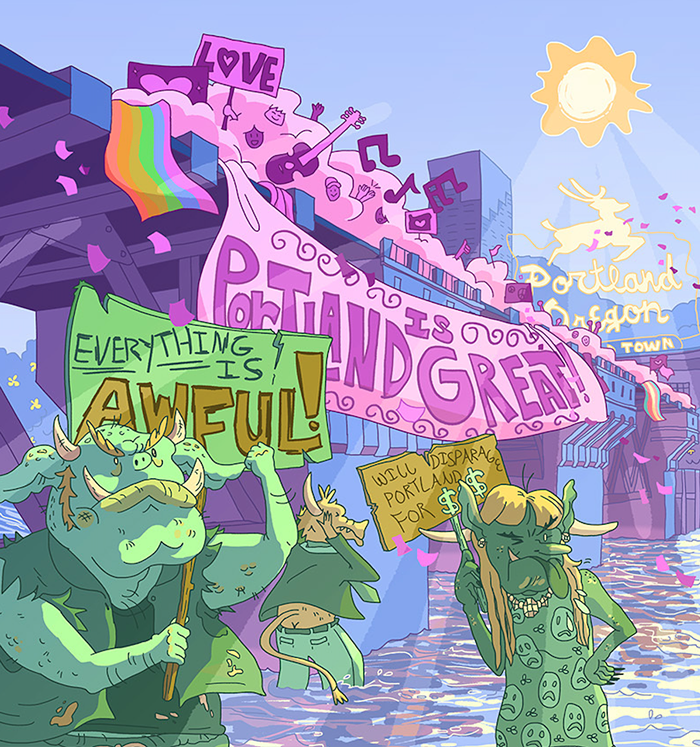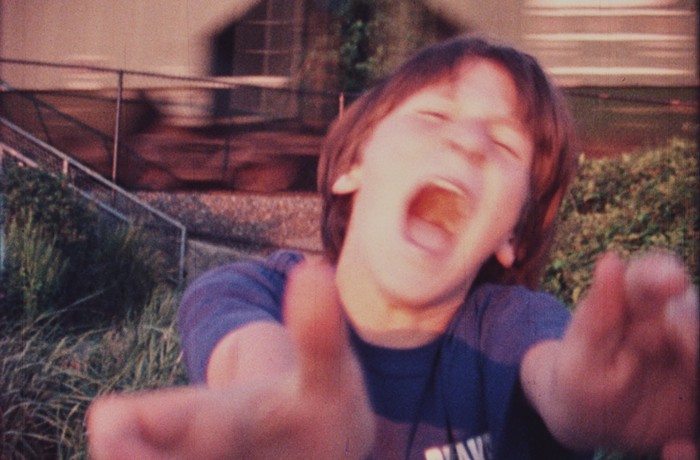That Show About the Weed Guy
Web Series High Maintenance Makes a Successful Transition to HBO
Cannabuzz: Just Don't Call It a Bud and Breakfast
A Look at the Cannabis-Friendly North Fork 53 Homestead
Cannabuzz: How to Make “So Damn Strong” Canna Cookies
You’re Welcome
Read the 2016 Oregon Cannabis Guide!
Your Annual Mini-Magazine About All Things Weed Has Arrived
Cannabuzz: Weed Reads
What to Read Before—and After—You Get High
Ask a Pot Lawyer: How to Get Your Weed Worker Permit
It’s Not Hard, But You’ll Need to Study Up—and Pony Up
Ask a Pot Lawyer: CBD Pet Treats Are a Thing?
Yep, They Are.
Weed Begins at 40
How I Got Back into the Pot Game
Ask a Pot Lawyer: Are We Headed Toward "Big Canna"?
Are Giant Marijuana Companies on the Way?
It’s Like a Humidor for Your Weed
We Tried Out the Cannador Storage System
My Roommate, the Weed Chemist
A Conversation with Green Leaf Lab About Canna Science
The Future of Oregon's Weed Industry
Our Cannabis Programs Are the Best in the Country
Roll Away the Stone: Great Stoner Albums You Need to Hear
More Than 100 Albums to Pack Your Bowl To
The Stoner Games
Perfect Summer Games to Play Under the Influence of Weed
How to be High in Public
(Don't Actually Do Any of These Things)
MUSIC AND MARIJUANA go together like milk and honey. So why is it that so many stoners have wretched taste in music? It could be argued that everything sounds better when you’re high, and that may very well be true—how else can one explain the longstanding success of bands like Sublime, 311, and Phish?
Weed can turn people into pretty forgiving listeners, but it shouldn’t make shitty music okay. In fact, it should make our standards higher, as pot can, for whatever reason, allow us to connect with unbridled creativity on a deeper level if we let it. (As far as remembering that connection once the record’s over? That’s a different story.) So throw away garbage like Kottonmouth Kings, and for god’s sake, get rid of those warbly Grateful Dead bootlegs. There’s a wealth of great, wild music to get baked to out there, and it goes far beyond played-out options like The Dark Side of the Moon and Bob Marley’s Legend.

The Pretty Things, S.F. Sorrow (1968)
It took decades, but the 1960s‘ greatest psychedelic masterpiece finally seems to have gotten its due. This is the album that made Sgt. Pepper’s resemble hash-addled hackwork, preceded Tommy’s idea of the album-length rock opera by several months, and sounded trippier than anything on The Piper at the Gates of Dawn. But you still won’t hear these songs on classic-rock radio, and despite its eventual recognition as one of the finest albums ever recorded, many stoners still have yet to roll up a doobie on its (admittedly pretty hideous) album jacket.
Marrying the Rolling Stones‘ schoolboy nastiness with lysergic hallucination, S.F. Sorrow is a Bildungsroman that follows the title character through love, war, death, and disillusionment, so one can see why it didn‘t win over many flower children during the sun-dappled aftermath of the Summer of Love. (Although it seemed to anticipate the grim happenings of 1969 with disturbing accuracy.) And while songs like “Death” and “Loneliest Person” end Sides 1 and 2, respectively, on bleak notes, there are also pop melodies, hard-rock bombast, Indian raga, and spine-tingling weirdness. If Sgt. Pepper’s definitively marked the end of the Beat boom, S.F. Sorrow opened the gates into a Wonka-world of sounds yet unheard by human ears. The current digital-age versions of the album include four bonus tracks of the splendid singles the Pretty Things released around this time; they’re just as essential as what went on the LP.

Wolf People, Steeple (2010)
Wolf People is, quite simply, the best heavy band to come out of Britain since Led Zeppelin and Black Sabbath. The quartet’s proper debut album, Steeple, followed some home recordings and CD-Rs (now collected on Tidings), and it’s a Stonehenge-sized collection of monolithic riffs, tangled guitar interplay, and minor-key British-ancestral balladry—albeit transposed to massive volumes. It doesn’t take much imagination to picture one’s self atop the mysteriously manmade Silbury Hill when listening the album’s opening track (“Silbury Sands”) or imagine armies of ghostly knights straight out of The Mabinogion colliding in ferocious but eerily silent assault in “One by One from Dorney Reach.” Their combo-pack of Wicker Man Brit-folk and Deep Purple bombast makes them a pothead’s dream band, particularly if you’ve worn out those grooves of Led Zeppelin III. Better yet, Wolf People never fall into the stoner-rock trap of locking into a mindless riff and repeating ad nauseam.
Wolf People’s follow-up album, Fain, offered a slightly streamlined version of their sound (although with plenty of fancy fretwork from Joe Hollick and Jack Sharp, two of the finest guitarists currently performing), and the 2013 EP When the Fire Is Dead in the Grate offered their sweetest, subtlest moment yet in the lonely “Become the Ground.” The band made their Portland-area debut in 2015 summer at the Pickathon festival, and their third album, the splendidly heavy Ruins, comes out this November on Jagjaguwar.

Lula Côrtes and Zé Ramalho, Paêbirú (1975)
This Brazilian psychedelic treasure is both gorgeous and unspeakably weird. A double album in which each of the four sides represents a different element—terra, ar, fogo, and água—Paêbirú ebbs and flows through interconnected movements, with fragments of folk melodies, guitars that buzz like bees, unearthly chanting, birdsong, amateur sound effects (either Côrtes or Ramalho makes fake wind blowy noises throughout “Harpa dos Ares”), and intensely primeval percussion. If that makes it sound like a drug-addled nightmare, there’s a real inventiveness and musical method to Côrtes and Ramalho’s madness, and Paêbirú is mysteriously intoxicating, each of its tracks dangling like overripe, forbidden fruits.
The mythology surrounding the album’s initial release adds another layer of intrigue: Almost all of the 1,000 original records were lost in either a flood or a fire, depending on which account you read—as if Mother Earth deemed humankind not yet ready for its beauty and reclaimed the album for herself. Naturally, this makes surviving copies among the most collectible albums on the planet, but you can just grab one of the recent reissues, or track it down on Spotify or YouTube.

O.C., Word...Life (1994); Cru, Da Dirty 30 (1997)
’90s hiphop is littered with perhaps hundreds of stoner classics, but for every milky Dr. Dre bong rip, there are bad seeds like Cypress Hill—bound to make you stupid and impotent. And yet the era was so rich that some of the best recordings remain relatively underground to this day. Bushwick emcee O.C. is still going strong, but his wonderful solo debut album, Word...Life, is his finest hour; it’s jazzy and loose, like a warm summer breeze easing through the neighborhood. Relatively slept-on at the time, the album’s been rehabilitated with the appearance of “Time’s Up” in 8 Mile—rightly so, as it’s got one of the best grooves ever laid to wax—and a deluxe reissue with remixes and bonus tracks.

The Bronx’s Cru didn’t last long, and their jam-packed debut Da Dirty 30—their only album—remains sorely neglected, one of the few instances in which the over-utilized template of beats, rhymes, and skits works like a charm. “Just Another Case” and the excellent “Bubblin’” are the hits you probably know (the former features a guest appearance from Slick Rick), but the album plays brilliantly as a whole, and despite some unfortunate period misogyny, it contains a youthful humor and generosity that’s hard to deny.

Genesis, The Lamb Lies Down on Broadway (1974)
Either you’ve heard this album—and you already know how insane it is—or you haven’t, and you’re likely thinking, “Genesis?!? Those old bald dudes who did that shitty song about how they couldn’t dance?” Fair ’nuff. But in the early ’70s, Genesis were the artiest of English art-rock bands, and lead singer Peter Gabriel (at this point, Phil Collins was just the drummer, and a really fucking great one) donned bizarre masks and costumes for the group’s lengthy, multi-part suites about aliens, Armageddon, and murderous vegetable uprisings. The band was on the brink of internal collapse when they decided to make their magnum opus, a long, confusing double concept album about a New York City graffiti artist who gets absorbed into a slow-moving ‘wall of death’ that creeps through Times Square. Once he’s on the other side, he has a series of bizarre adventures in the vein of Pilgrim’s Progress and Alice in Wonderland, except with a lot more Freudian sexual imagery. (At one point our hero is emasculated out of medical necessity, and wears his newly detached member in a tube around his neck—a plot point that gave King Missile their entire career.)
The long explicatory story on the album’s inner gatefold doesn’t really make sense of Gabriel’s foundry of dreamlike ideas, but the music is breathtaking—strange, ethereal, occasionally heavy, then precise and delicate. Tony Banks’ mellotron and primitive synthesizers yawl and hum all over the place, and the rest of the band decimates their prog-rock peers with whip-tight jamming on songs like “In the Cage” and “Riding the Scree.” But there’s also room for shiver-inducing moments like the whisper-quiet instrumental “Silent Sorrow in Empty Boats” and the amniotic, sodium-lamp warmth of “The Carpet Crawlers.” Avoid the current edition of the album, a 2008 digitally compressed remix that robs the music of its dynamics and subtlety; instead, find an old copy on Discogs or in the used bins.

David Bowie, Hunky Dory (1971)
This isn’t a particularly obscure album, or even all that stoney, but Bowie’s one-album-long incarnation as an Elton John-ish singer/songwriter concludes with perhaps the greatest stoner song of all time: the magnificently oddball “The Bewlay Brothers,” which completely obliterates the 35 minutes of toe-tapping cheer that preceded it. With a phalanx of needle-sharp acoustic guitars and very little else, Bowie quickly invokes a stream-of-consciousness scroll of nervous ideas and images, with lines like “I was stone and he was wax/so he could scream and still relax” and “He’s chameleon, comedian, Corinthian, and caricature” making way for the song’s rising, red-eyed chorus, an oblique howl that’s unbearably tense. Yet all hell doesn’t break loose until the madcap coda, where Bowie, overdubbing his voice a dozen times at varying tape speeds, allows the walls of lunacy and fear to descend.
Bowie adored his older brother, Terry, who had well-documented mental health troubles, and he’s the ghost in the machine here, a shadowy figure that lurks at the song’s outer edges. Bowie himself never claimed to know what any of “The Bewlay Brothers” meant, but in one fell swoop, he out-Rimbaud-ed Bob Dylan and made the most gripping, paranoid stoner song of all time.
100 (More) Great Weed-Friendly Albums
We put out the call to trusted writers, friends, and stoners, asking for their very favorite records to get high to. Turns out, the people we know really like getting stoned while listening to music. Here’s an exhaustive rundown of their 100 favorite albums to put on while lighting up—it should be plenty to fuel your next year’s worth of pot playlists.
Air, The Virgin Suicides (2000, France)
Amon Düül II, Yeti (1970, Germany)
Ashra, Blackouts (1977, Germany)
Beastie Boys, Check Your Head (1992, USA)
Chris Bell, I Am the Cosmos (1992, USA)
The Black Angels, Passover (2006, USA)
Blue Cheer, Outsideinside (1968, USA)
Boredoms, Super æ (1998, Japan)
Boris, Pink (2005, Japan)
The Boyoyo Boys, Back in Town (1987, South Africa)
The Byrds, The Notorious Byrd Brothers (1968, USA)
Can, Tago Mago (1971, Germany)
Cat Power, Moon Pix (1998, USA)
Los Chiriguanos, Guarini Songs and Dances (1960, Paraguay)
Cocteau Twins, Heaven or Las Vegas (1990, UK)
Bootsy Collins, Ahh... The Name Is Bootsy, Baby! (1977, USA)
John Coltrane, Live at Birdland (1964, USA)
Cornershop, Woman’s Gotta Have It (1995, UK)
The Creation, We Are Paintermen (1967, UK/Germany)
Miles Davis, In a Silent Way (1969, USA)
The Devil’s Blood, The Thousandfold Epicentre (2011, Netherlands)
Digable Planets, Reachin’ (A New Refutation of Time and Space) (1993, USA)
J Dilla, Donuts (2006, USA)
DJ Kid Slizzard, For the Weed Smokers (2011, USA)
Nick Drake, Bryter Layter (1970, UK)
The Dukes of Stratosphear, 25 O’Clock (1985, UK)
Dungen, Ta Det Lungt (2004, Sweden)
Brian Eno, Apollo: Atmospheres and Soundtracks (1983, UK/Canada)
Fairport Convention, Liege & Lief (1969, UK)
The Feelies, Crazy Rhythms (1980, USA)
The Flaming Lips, In a Priest Driven Ambulance (1990, USA)
Fripp & Eno, No Pussyfooting (1973, UK)
Funkadelic, Maggot Brain (1971, USA)
Ghost, In Stormy Nights (2007, Japan)
Gilberto Gil, Gilberto Gil (1968, Brazil)
Dizzy Gillespie, An Electrifying Evening with the Dizzy Gillespie Quintet (1961, USA)
Goat, Commune (2014, Sweden)
Googoosh, Googoosh (2011, Iran)
Alain Goraguer, La Planète Sauvage (1973, France)
Handsome Boy Modeling School, So... How’s Your Girl? (1999, USA)
Shin Joon Hyun, Beautiful Rivers and Mountains (2011, South Korea)
Jex Thoth, Blood Moon Rise (2013, USA)
The Kinks, Face to Face (1966, UK)
Fela Kuti, Gentleman (1973, Nigeria)
Cate Le Bon, Cyrk (2012, UK)
Madvillain, Madvillainy (2004, USA)
The Master’s Apprentices, Choice Cuts (1971, Australia)
Mercury Rev, Yerself Is Steam (1991, USA)
Charles Mingus, The Clown (1957, USA)
Morgen, Morgen (1969, France)
Morphine, Cure for Pain (1993, USA)
Van Morrison, Astral Weeks (1968, USA/Northern Ireland)
Mott the Hoople, Mott (1973, UK)
The Move, Shazam (1970, UK)
Junior Murvin, Police and Thieves (1977, Jamaica)
Os Mutantes, Os Mutantes (1968, Brazil)
My Bloody Valentine, Loveless (1991, UK)
Willie Nelson, Red Headed Stranger (1975, USA)
Neu!, Neu! (1972, Germany)
90 Day Men, To Everybody (2002, USA)
Nudity, The Nightfeeders (2008, USA)
Angel Olsen, Burn Your Fire for No Witness (2014, USA)
Shuggie Otis, Inspiration Information (1974, USA)
Outkast, Aquemini (1998, USA)
The Pharcyde, Bizarre Ride II the Pharcyde (1992, USA)
PRhyme, PRhyme (2014, USA)
Primal Scream, Screamadelica (1991, UK)
N. Ravikiran, Taj Mahal, V.M. Bhatt, Mumtaz Mahal (1995, India/US)
Rush, 2112 (1976, Canada)
Ty Segall and White Fence, Hair (2012, USA)
Sleep, Holy Mountain (1992, USA)
Sly and the Family Stone, There’s a Riot Goin’ On (1971, USA)
Small Faces, Ogden’s Nut Gone Flake (1968, UK)
Sonic Youth, Daydream Nation (1988, USA)
The Soundtrack of Our Lives, Behind The Music (2001, Sweden)
Spiritualized, Ladies and Gentlemen We Are Floating in Space (1997, UK)
Pops Staples, Don’t Lose This (2015, USA)
The Rain Parade, Emergency Third Rail Power Trip (1983, USA)
Stereolab, Dots and Loops (1997, UK)
The Stone Roses, The Stone Roses (1989, UK)
George Strait, Icon/Best of George Strait (2011, USA)
Super Furry Animals, Rings Around the World (2001, UK)
Tame Impala, Lonerism (2012, Australia)
The Teardrop Explodes, Kilimanjaro (1980, UK)
Temples, Sun Structures (2014, UK)
Thin Lizzy, Jailbreak (1976, Ireland)
Toots and the Maytals, Funky Kingston (1975, Jamaica)
Tomorrow, Tomorrow (1968, UK)
Peter Tosh, Equal Rights (1977, Jamaica)
Various Artists, Cult Cargo: Belize City Boil Up (2005, Belize)
Caetano Veloso, Caetano Veloso (1969, Brazil)
Kurt Vile, Smoke Ring for My Halo (2011, USA)
Wand, Golem (2015, USA)
We All Together, We All Together (1972, Peru)
The Who, The Who Sell Out (1967, UK)
Chelsea Wolfe, Pain Is Beauty (2013, USA)
Wu-Tang Clan, 36 Chambers: Enter the Wu-Tang (1993, USA)
Yes, Relayer (1975, UK)
Neil Young, Tonight’s the Night (1975, USA/Canada)
Yuck, Yuck (2011, UK)












